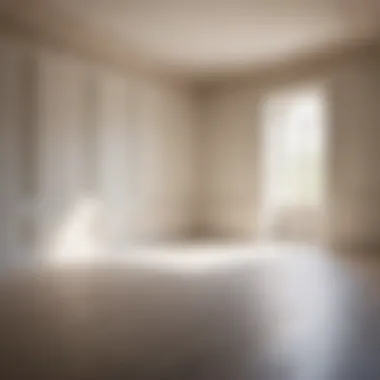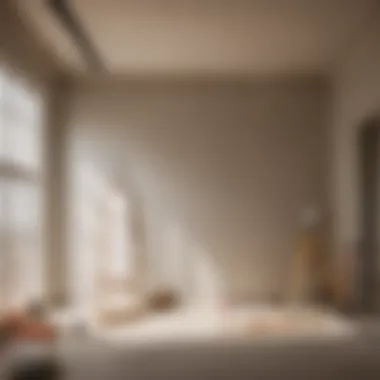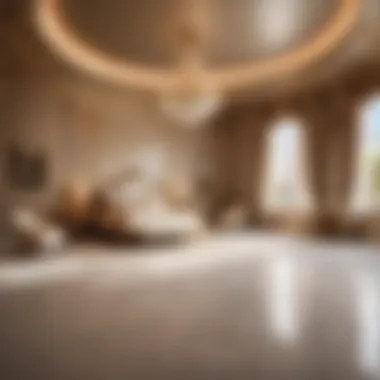Materials:
When embarking on a drywalling project, it is essential to have all the necessary materials on hand to ensure a smooth and successful process. Here is a detailed list of items you will need:
- Drywall sheets: Purchase the appropriate amount based on the square footage of the room. Measure the dimensions accurately to avoid excess or shortage.
- Drywall screws: Opt for corrosion-resistant screws to secure the drywall sheets to the walls efficiently.
- Joint compound: Invest in a high-quality joint compound for seamless finishing and repairing imperfections.
- Drywall tape: Essential for reinforcing seams and preventing cracking over time.
- Sandpaper: Choose different grits for smoothing surfaces and achieving a polished final look.
- Primer and paint: Select suitable primer to prep the drywall for paint, followed by your desired paint colors.
DIY Steps:
Before diving into the drywalling process, it is crucial to plan and execute each step meticulously. Here is a step-by-step guide:
- Measure and plan: Accurately measure the dimensions of the room and calculate the amount of drywall needed.
- Prepare the workspace: Clear the room of furniture and ensure a clean, debris-free surface for installation.
- Install the drywall: Start by cutting the drywall sheets to size and screwing them onto the walls securely.
- Taping and mudding: Apply drywall tape over the seams and cover them with joint compound for a seamless finish.
- Sand and smooth: Once the compound is dry, sand the surface to achieve a uniform texture.
- Prime and paint: Finish off by priming the walls to seal the drywall and paint them in your desired colors.
Technical Aspects:
To enhance the quality and uniqueness of your drywall project, pay attention to the following technical aspects:
- Tools: Gather essential tools such as a utility knife, t-square, drywall saw, and drywall screw gun for efficient installation.
- Timing specifics: Estimate the time required for each step, including drying times for joint compound and paint.
- Critical techniques: Master feathering edges while mudding and sanding for a professional-looking finish.
DIY Project Process:
The sequential steps in drywall installation are crucial for a successful outcome. Follow these steps for a flawless finish:
- Measure and cut drywall accurately to ensure a precise fit on walls and ceilings.
- Use the right amount of joint compound to cover seams and imperfections evenly.
- Sand lightly between coats for a smooth, seamless finish without visible marks.
- Address common issues like uneven seams or bubbles promptly to maintain the quality of your walls.
- Enjoy the final result of your meticulous drywalling project, enhancing the look and feel of your space.
Troubleshooting Tips:


In case of common mistakes during the drywalling process, here are some quick solutions:
- Uneven seams: Sand down the edges and apply additional joint compound for a smooth transition.
- Cracks or bubbles: Cut out the damaged area, re-tape, and re-mud for a seamless repair.
- Paint issues: Sand the surface lightly and apply an additional coat of primer before repainting.
Introduction


In the realm of home improvement projects, drywalling a room is a fundamental yet crucial component. This essential process sets the foundation for the aesthetics and functionality of any space, making it imperative to understand the intricacies involved in its cost evaluation. The introduction serves as a gateway into unraveling the mysteries of drywall costs, shedding light on the myriad factors that influence pricing. From material considerations to labor expenses, each aspect plays a pivotal role in determining the overall expenditure of this common renovation endeavor. By delving into the complexities of cost breakdown, individuals can gain invaluable insights that empower informed decision-making when embarking on their own drywalling journey.
Factors Affecting Drywall Cost


In this section of the article, we will delve into the crucial aspects that influence the overall cost of drywalling a room. Understanding the factors affecting drywall cost is essential for anyone planning a home improvement project involving drywall installation. By examining these specific elements, benefits, and considerations, one can make informed decisions and effectively manage their budget.
Room Size
When it comes to drywall cost, the size of the room plays a significant role. Larger rooms require more materials and labor for installation, consequently increasing the overall costs. Room size directly impacts the amount of drywall sheets needed, taping, mudding, and sanding work, all of which contribute to the final expense. It's vital to accurately measure the dimensions of the room to estimate cost accurately and avoid underestimating materials or labor needs.
Type of Drywall
The type of drywall chosen for a project also influences the cost. Different drywall materials come at varying price points, from traditional gypsum board to specialized options like moisture-resistant or fire-resistant drywall. Each type has unique properties and benefits, affecting both material costs and installation complexity. Evaluating the specific requirements of the room, such as moisture levels or fire safety considerations, will guide the selection of the appropriate drywall type to meet both functional needs and budget constraints.
Labor Costs
Labor expenses are a crucial component of drywall cost. Skilled labor is necessary for proper drywall installation, including hanging, taping, and finishing. Labor costs can vary based on factors such as geographical location, project complexity, and the experience level of the workers. It's important to obtain multiple quotes from reputable contractors, considering both price and quality of work. Understanding the breakdown of labor costs within the overall budget is essential for budget planning and ensuring a successful project outcome.
Additional Features
Incorporating additional features into the drywall project, such as intricate designs, archways, or built-in shelving, can significantly impact costs. These customized elements require specialized skills and may involve additional material expenses beyond standard drywall installation. While adding unique features can enhance the aesthetic appeal of the room, it's essential to weigh the cost implications against the desired design outcomes. Clear communication with contractors regarding any extra features will help manage expectations and budget effectively.
Geographical Location
The geographical location of a project site can affect drywall costs due to variations in labor rates, material prices, and local building codes. Urban areas or regions with high living costs typically have higher labor rates, reflecting the overall cost of construction projects. Remote or rural locations may encounter challenges in sourcing materials, leading to increased prices or longer delivery times. Understanding the influence of geographical location on drywall costs allows for better budget forecasting and project planning, mitigating potential cost overruns.
Cost Breakdown
In the realm of home improvement projects, understanding the cost breakdown is paramount, particularly when it comes to drywalling a room. The cost breakdown section within this comprehensive guide serves as a crucial focal point, shedding light on the specific elements that factor into the overall cost estimation. By dissecting the expenses involved in material procurement, labor fees, and potential additional features, readers gain a detailed insight into the financial aspects of this endeavor.
Delving into the cost breakdown allows homeowners to grasp the intricate balance between material costs and labor expenses. It empowers individuals to make informed decisions regarding budget allocation and cost management throughout the project. Furthermore, by outlining the critical components that contribute to the overall expenditure, such as the type of drywall, room size, geographical location, and labor rates, this section equips readers with the necessary knowledge to navigate the financial landscape of drywall installation efficiently.
Materials
When embarking on a drywall project, the selection of materials plays a pivotal role in determining both the quality of the outcome and the overall cost. Whether opt for traditional gypsum board or more advanced options like moisture-resistant or fire-resistant drywall, the material choice sets the foundation for the project's durability and aesthetic appeal. Factors such as the room's function, moisture levels, and desired insulation properties influence the material decision-making process.
Moreover, considering additional materials such as joint compound, screws, tape, and sandpaper is crucial for achieving a professional finish. Evaluating the quantity required based on the room size and intricacies of the project ensures a seamless installation process and minimizes wastage. By exploring different material options and understanding their respective advantages and cost implications, homeowners can make well-informed choices tailored to their specific needs and budget constraints.
Labor
The labor component of drywall installation comprises a significant portion of the overall project cost and directly impacts the quality and efficiency of the work. Hiring skilled professionals ensures a smooth and precise installation, mitigating potential errors and imperfections that may arise from inexperienced labor. Labor costs are influenced by factors such as the complexity of the project, time required for completion, and prevailing market rates.
Additionally, negotiating labor costs and seeking competitive quotes from multiple contractors enable homeowners to optimize their budget and secure a cost-effective yet proficient workforce. Understanding the labor breakdown, including tasks such as hanging, taping, mudding, and sanding, empowers individuals to assess the value provided by different contractors and make an informed hiring decision.
By emphasizing the importance of material selection and labor considerations in the context of drywall installation, this guide equips readers with the knowledge and insight necessary to navigate the cost dynamics of this common home improvement project effectively.
Common Drywall Costs
In the realm of drywalling projects, understanding common costs is paramount to planning and budgeting effectively. Common drywall costs encompass a range of elements that contribute to the overall expenses associated with this endeavor. From material prices to labor fees, and additional features that may enhance or elevate the cost, having a clear grasp of what constitutes common drywall costs is crucial.
Factors such as the type of drywall being used, the size of the room, and any special features like mold-resistant or fire-resistant properties can all influence the final cost. Moreover, geographic location plays a significant role, as labor rates and material availability vary across regions.
Acknowledging the common drywall costs enables homeowners to make informed decisions, allocate funds appropriately, and avoid unexpected financial surprises during the project. By delving into the specific aspects that contribute to these costs, individuals can better plan for the financial aspect of drywalling a room.
Per Square Foot
When estimating the cost of drywall installation, calculating the expense per square foot is a common practice. This metric provides a straightforward way to gauge the financial implications of the project based on the room's size. Knowing the cost per square foot helps homeowners budget effectively and determine the overall investment required for the endeavor.
Several variables impact the cost per square foot, including the quality of the drywall material, the complexity of the installation process, and any additional features or customizations desired. Understanding this aspect of pricing allows homeowners to compare quotes from contractors, assess different material options, and ultimately make informed decisions regarding their budget.
Average Room Costs
In addition to calculating costs based on square footage, determining the average room costs for drywalling provides a more holistic perspective on the overall expenditure. Average room costs take into account not only the surface area to be covered but also the intricacies of the space, such as corners, windows, and doors that may affect pricing.
Factors like the height of the ceiling, the need for scaffolding, and the presence of intricate architectural details can all impact the average room costs. By considering these variables alongside the square footage, homeowners can obtain a more comprehensive understanding of the financial commitment required for the project.
Additional Features
Beyond the fundamental aspects of drywall installation, additional features can add both aesthetic appeal and functional benefits to a room. These features, such as soundproofing properties, moisture resistance, or textured finishes, contribute to the overall cost of the project.
While opting for additional features may increase the upfront expenses, they can enhance the durability, functionality, and aesthetics of the space in the long run. Understanding the impact of these add-ons on the overall cost allows homeowners to weigh the value they bring against the investment required, making informed choices that align with their preferences and budget.
Ways to Save on Drywall Costs
In a thorough analysis of the costs associated with drywalling a room, it is imperative to delve into various strategies to save on expenses without compromising on quality. One of the key aspects that significantly impacts the overall cost of a drywall project is whether to opt for a do-it-yourself (DIY) approach or hire professionals. By understanding the intricacies and benefits of each option, individuals can make informed decisions that align with their budget and timeline.
DIY vs. Hiring Professionals
Taking on a DIY drywall project can result in substantial cost savings as it eliminates the need to pay for labor. However, it is essential to consider the skill level required for such a task. While DIY may be suitable for individuals with prior experience or a willingness to learn through tutorials and guides, it can be time-consuming and pose risks if not done correctly. On the other hand, hiring professionals ensures expertise and efficiency but comes at a higher cost. Professional contractors bring years of experience, specialized tools, and the ability to complete the job swiftly and with professional craftsmanship.
Comparison Shopping
Another effective way to save on drywall costs is through comparison shopping. By obtaining quotes and estimates from multiple suppliers and contractors, homeowners can compare prices, services offered, and overall value. It is essential to look beyond the initial cost and consider factors such as the quality of materials, reputation of the contractor, and any additional services provided. By conducting thorough research and negotiating with different vendors, individuals can ensure they get the best deal without compromising on the project's quality.
Negotiating Labor Costs
Negotiating labor costs is a crucial aspect of controlling expenses during a drywall project. While labor expenses can make up a significant portion of the overall budget, there is often room for negotiation, especially when dealing with independent contractors. Homeowners can explore options such as bundling multiple projects for a discounted rate, scheduling work during off-peak seasons, or offering to assist with the labor to reduce costs. Effective communication and clear expectations can pave the way for mutual agreements that benefit both parties involved.
Conclusion
In wrapping up the comprehensive guide on the costs associated with drywalling a room, it is vital to reiterate the significance of understanding these financial implications before embarking on such a project. The conclusion serves as a pivotal point where all the information provided throughout the article culminates into actionable insights for individuals considering drywalling in their homes. By thoroughly exploring factors such as room size, type of drywall, labor costs, additional features, and geographical location, readers are equipped with a detailed understanding of the expenses involved in this common home improvement endeavor.
Moreover, the conclusion brings to light the benefits of meticulous planning and budgeting when undertaking a drywalling project. By having a clear overview of the costs breakdown, including materials and labor, homeowners can make informed decisions that align with their financial capabilities and desired outcomes. Additionally, the importance of considering ways to save on drywall costs, such as DIY options, comparison shopping, and negotiating labor expenses, is underscored in this final section.
Lastly, the conclusion of this guide underscores the necessity of thorough research and proper budget allocation to ensure a successful and cost-effective drywalling experience. By delving into the nuances of pricing elements and highlighting key considerations, readers are empowered to approach their home improvement projects with confidence and preparedness, ultimately leading to a satisfactory outcome that enhances both the functionality and aesthetic appeal of their living spaces.





